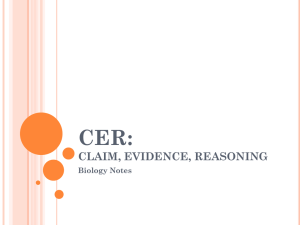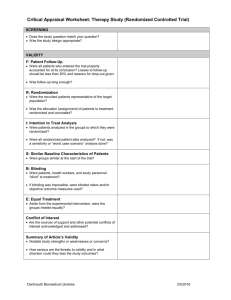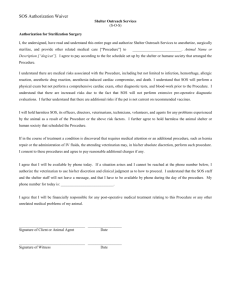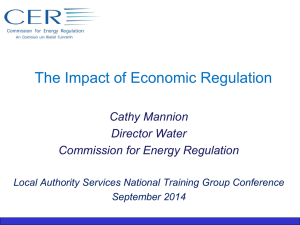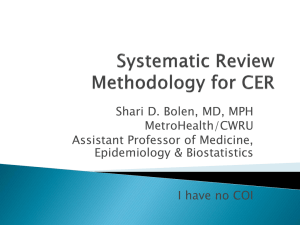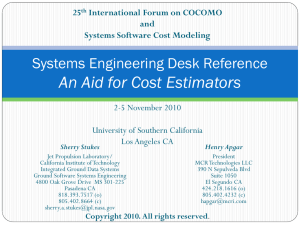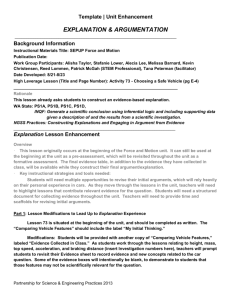CER 15098A - Commission for Energy Regulation
advertisement
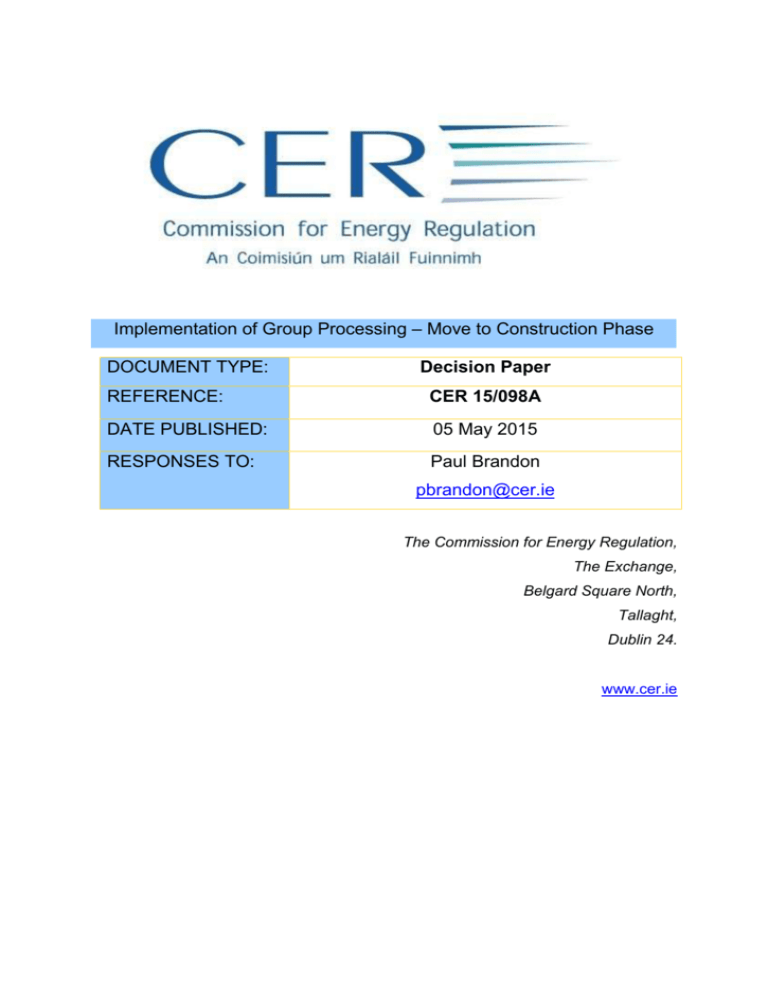
Implementation of Group Processing – Move to Construction Phase DOCUMENT TYPE: Decision Paper REFERENCE: CER 15/098A DATE PUBLISHED: 05 May 2015 RESPONSES TO: Paul Brandon pbrandon@cer.ie The Commission for Energy Regulation, The Exchange, Belgard Square North, Tallaght, Dublin 24. www.cer.ie CER – Information Page Target Audience: This Decision Paper is most applicable to all generators who are members of a subgroup as defined under the Group Processing Approach whose connection method involves shared works with other developers. Section 3 also covers scenarios applicable to standalone developers. Related documents - Gate 3 Direction – Criteria for Gate 3 Renewable Generator Offers & Related Matters, CER/08/260 - Connection Offer Policy and Process (COPP), CER/11/093 - System Operator GPA Pricing Principles Decision Paper, CER/10/085 - Decision on Electricity Network Connection Policy, CER/09/138 - Decision on Distribution Connection Contracts, CER/09/198 - Treatment of Small, Renewable and Low Carbon Generators outside the Gate Processing Approach, CER/09/099 - Decision on Relocation of Generation Capacity, CER/10/211 - Decision on First Stage Payments on Acceptance of a Connection Offer to the Electricity Network, CER/10/233 - Consultation Paper – Implementation of Group Processing – Move to Construction Phase, CER/14/432 - Modification Fees for Connection Offers, CER/13/094 - Information Memorandum on Longstop Dates for Generation Connection Agreements - Transmission Connection Agreement and General Conditions - Distribution Connection Agreement and General Conditions 2 Executive Summary In summer 2014, the System Operators (“SOs”) developed and submitted to the CER, a paper – the ‘Implementation of Group Processing – Move to Construction Phase’ (the “Consultation Paper”) – which detailed their proposals for managing projects and subgroups as they move into the construction phase of delivery and to obtain the views of the electricity industry (the “Industry”) and the public on these proposals. The intention of the proposals was to develop a set of guidelines and a ruleset that provides further clarity, transparency and flexibility to the management of projects and subgroups through the construction phase of delivery. In August 2014, the SOs published the Consultation Paper, (CER/14/432). The consultation closed in September 2014 and six responses were received providing views on some or all of the issues in the Consultation Paper. The responses are summarised by the SOs in their recommendation paper (the “SO Recommendation Paper”) published alongside this Decision Paper. The SO Recommendation Paper sets out the SOs’ position, responses, views and conclusions in relation to each section of the Consultation Paper and summarises comments and proposals from respondents. The SO Recommendation Paper also includes the updated Ruleset following the consultation process. This Decision Paper sets out the CER’s decision on each of the core aspects of the SOs’ approach as initially proposed in the Consultation Paper, and the CER’s position on the recommendations in the SO Recommendation Paper and Ruleset submitted by the SOs for approval following the consultation process. One of the key changes following the consultation is the recommendation by the SOs of ‘Option 1 – Invoice and Terminate’ initially outlined in Section 4.5 of the Consultation Paper, which has now been slightly amended and is formally approved in this Decision Paper. The SOs’ revised Ruleset is based on ‘Option 1 – Invoice and Terminate’ and sets out the guiding principles and associated processes for progressing projects and subgroups into the construction phase. The Ruleset is set out in the SO Recommendation Paper, which is published alongside this Decision Paper and has been approved by the CER. 3 In arriving at its decision on each aspect of the SOs’ recommendations, the CER has considered the views of Industry and the need for further clarity on the approach to subgroup progression in the current Gate 3 process. 4 Table of contents 1 2 Introduction .......................................................................................................... 6 1.1 The Commission for Energy Regulation ........................................................ 6 1.2 Purpose of this Decision Paper ..................................................................... 6 1.3 Background ................................................................................................... 6 1.4 Structure of this Decision Paper .................................................................... 7 1.5 Scope of this Decision Paper ........................................................................ 8 1.6 Principles ...................................................................................................... 8 Proposed approach in scenarios that arise that have the potential to impact on build out of a Standalone Developer ........................................................................ 10 2.1 Accepts offer but requests modification (section 3.1) .................................. 10 2.2 Accepts offer but requests that project is put on hold (section 3.2) ............. 11 2.3 Accepts offer but does not make Second Stage (pre-construction) Payment (section 3.3) .......................................................................................................... 12 3 Proposed approach in scenarios that arise that have the potential to impact on build out of Group Developments ............................................................................. 12 3.1 Offer(s) of at least one group member not accepted (section 4.1) .............. 13 3.2 Full group accepts but a group member seeks a modification (section 4.2) 14 3.3 A group member disputes prior to offer acceptance (section 4.3) ............... 16 3.4 A group member accepts and then disputes (section 4.4) .......................... 17 3.5 Group members have accepted offers but are not ready to progress to Second Stage Payment at the same time (consultation section 4.5) .................... 19 4 Additional offering in advance of Second Stage Payment ................................. 21 5 System Operator Ruleset .................................................................................. 22 6 Conclusion ......................................................................................................... 23 5 1 Introduction 1.1 The Commission for Energy Regulation The Commission for Energy Regulation (CER) is the independent body responsible for overseeing the regulation of Ireland's electricity and gas sectors. The CER was established and granted regulatory powers over the electricity market under the Electricity Regulation Act 1999. The Gas (Interim) (Regulation) Act 2002 expanded the CER’s jurisdiction to include regulation of the natural gas market, while the Energy (Miscellaneous Provisions) Act 2006 granted CER powers to regulate the activities of electrical contractors with respect to safety; to regulate the activities of natural gas undertakings involved in the transmission, distribution, storage, supply and shipping of gas; and to regulate the activities of natural gas installers with respect to safety. The Electricity Regulation Amendment (SEM) Act 2007 outlined CER’s functions in relation to the Single Electricity Market (SEM) for the island of Ireland. This market is regulated by the CER and the Northern Ireland Authority for Utility Regulation (NIAUR). The CER is working to ensure that consumers benefit from regulation and the introduction of competition in the energy sector. 1.2 Purpose of this Decision Paper The purpose of this Decision Paper is to set out the CER’s position and decision on the proposals as set out in the original Consultation Paper, ‘Implementation of Group Processing – Move to Construction Phase’, (CER/14/432) and the subsequent SO Recommendation Paper which includes the revised Ruleset. 1.3 Background In May 2011, the CER approved the Connection Offer Policy and Process (“COPP”) Paper, as well as an additional joint document prepared by the SOs, which was published alongside the CER Decision Paper. The purpose of that document was to provide applicants and projects with offers seeking to connect, with a clear set of guidelines in relation to connection offer policy. 6 Section 10 of the COPP Paper focussed on the baseline principles behind Group Processing and in particular what happens to a subgroup if a group member does not accept their offer and/or terminates their offer at a later stage. Section 10 also dealt with minimising stranded assets in the scenario where a group member wished to change their connection method. The SOs’ Consultation Paper on Implementation of Group Processing was developed with reference to the decisions in Section 10 of the COPP Paper and outlined the treatment of a number of different scenarios in relation to projects being progressed into the construction phase. The purpose of this Decision Paper is to now set out the key sections consulted on in the Consultation Paper, the SOs’ recommendations following consideration of all the responses as set out in the SO Recommendation Paper, the CER’s position on the issues in the consultation and the CER’s decision on same. This Paper and the accompanying Ruleset should provide clarity to developers around the approach that will be taken by the SOs in a range of group processing scenarios, as developers move or seek to move into construction phase. However, where a developer is not clear on the approach which will be taken, they should contact the appropriate SO for clarity in the first instance. The SOs have also developed a Ruleset to implement these changes, which is included in the SO Recommendation Paper to the CER, which was further developed on foot of the consultation responses. The current rules for the progression of subgroups are dealt with in the COPP Paper. The intention of the Consultation Paper and subsequent SO Recommendation Paper submitted to the CER is to expand on Section 10 of the COPP Paper, in particular focussing on the challenges facing project delivery where the actions of developer(s) have the potential to impact on same. 1.4 Structure of this Decision Paper This Decision Paper should be read in conjunction with the SO Recommendation Paper and the approved Ruleset contained in Appendix B of that paper, which has been published alongside this Decision Paper. The SO Recommendation 7 Paper contains the detail on the approach to progression of subgroups and the rationale for each aspect of the Ruleset. The CER’s Decision Paper does not attempt to repeat this detail but rather it focuses on clarifying the CER’s reason for approval on each of the key areas of the Ruleset. Section 2 of this Decision Paper sets out the proposed approach in scenarios that arise that have the potential to impact on build out of a standalone developer and the CER’s decision in these areas. Section 3 outlines the proposed approach in scenarios that arise that have the potential to impact on build out of group developments and the CER’s decision in these areas. 1.5 Scope of this Decision Paper Contestability was not considered as part of this consultation as the CER and SOs are not a party to the commercial/contractual arrangements that exist between group members in contestable scenarios. In addition, both DSO and TSO contestability has been consulted on previously with separate decisions outlined in these areas. Therefore, this Decision Paper applies to non-contestable scenarios only. The Consultation Paper examined the relationship between progression of works and the payment of the associated charges, including the Second Stage Payment (“SSP”) and all subsequent stage payments after the SSP. 1.6 Principles In arriving at a decision on the proposed Ruleset and the SOs’ recommendations, the CER has considered the following set of principles. These serve as guidance in relation to the overall objective of this work and the various scenarios that may arise. 8 - Developers who are in a position to proceed and have paid/are willing to pay their stage payments should be accommodated to the extent possible; - The UoS customer is protected to the extent possible from any additional exposure/risk, noting that there are some scenarios where it is appropriate for the UoS customer to make a contribution; - Mechanisms are in place to ensure that developers who have not paid their stage payments do not cause any undue delays for other subgroup members; and - The SOs continue to work with their customers in order to ensure delivery of the necessary network assets to facilitate Gate 3 windfarm developments and the achievement of the 2020 renewable targets. In particular, where reoptimisation studies are necessary, the SOs should take all reasonable efforts to complete these studies in as short a timeframe as possible, noting that studies may be complex. 9 2 Proposed approach in scenarios that arise that have the potential to impact on build out of a Standalone Developer For the avoidance of doubt, the points below are a summary only of the main points in relation to this section as set out in the SO Recommendation Paper and the Ruleset in Appendix B of that paper. It is important that you read the SO Recommendation Paper and the Ruleset contained therein, which accompanies this CER Decision Paper, for full details of the rules now being approved in this CER Decision Paper. The CER approved Ruleset contained in Appendix B of the SO Recommendation Paper should remain as the key reference point for developers seeking clarity. 2.1 Accepts offer but requests modification (section 3.1) 2.1.1 Where a modification request from a standalone developer is likely to impact on the progression of connection works for other developers, the SOs propose that the consent of affected parties should be required to allow that modification to progress. 2.1.2 In addition, the TSO has offered an advanced works package to generally apply to pre Consents Issue Date (CID)1 works, such as planning, functional specifications and design. Modification of the connection method after CID in general would not be allowable and so the scope for Advanced Works Packages post CID is very limited in terms of facilitating the progression of post CID works. 2.1.3 The CER notes the respondents’ views that it is reasonable to request the consent of each affected party where a modification is being sought by a standalone developer. 2.1.4 Further information on Advanced Work Packages is available on the TSO website.2 2.1.5 CER is of the view that the approach as proposed by the SOs is reasonable and will provide greater clarity to developers and the SOs. Accordingly, the CER has decided to approve the SOs’ recommended Consents Issue Date is a defined term in the TSO’s General Conditions of Connection and Transmission Use of System (the “General Conditions”). 2 http://www.eirgrid.com/media/Application%20for%20Transmission%20Advanced%20Works%20Packages.pdf 1 10 approach and the proposed Ruleset. 2.2 Accepts offer but requests that project is put on hold (section 3.2) 2.2.1 To make a request to put a project on hold a developer must make a formal request in writing to their SO, which will require assessment as it potentially introduces risk for the SO/UoS customer. 2.2.2 The SOs recommend that where a standalone developer accepts its offer and requests that the project be put on hold, and where placing the project on hold does not impact on other developers or the wider development of the transmission or distribution system, this request will generally be granted. Where it is not being granted, the SO will be required to set out the rationale for not granting the request. 2.2.3 It should be noted that where delivery of the project underpins an investment decision in the transmission or distribution networks then the SO may not be able to facilitate a request for a project to go on hold. For example, where the development of a project offsets a requirement for an investment in new network, the SO may refuse a request to put that project on hold. 2.2.4 For clarity and in line with the existing rules, longstop dates are unlikely to be extended where a project has been put on hold. Where a project is on hold and reaches its longstop date, the SO will normally exercise their right to terminate the Connection Agreement. In cases where the project is on hold due to factors outside the control of the developer, the SO may decide to exercise its discretion and revise the longstop dates in line with current rules. 2.2.5 There is a clear distinction to be made between a developer request to put a project on hold and a project being placed on hold due to delays that are outside the control of the developer, such as, uncertainty about the SOs’ solution to a connection or uncertainty relating to the planning process. 2.2.6 In addition to the longstop date element outlined above, the SOs’ resources will be diverted from a project that is put on hold and it loses its place in the overall transmission/distribution programme of works. Therefore, when the project is taken off hold, a revised set of lead times 11 will be issued by the relevant SO. 2.2.7 CER is of the view that the approach as proposed by the SOs is reasonable and will provide greater clarity to developers and the SOs. Accordingly, the CER has decided to approve the SOs’ recommended approach as specifically set out in the Ruleset. 2.3 Accepts offer but does not make Second Stage (pre-construction) Payment (section 3.3) 2.3.1 Where a standalone developer does not make their SSP or has requested that the issuance of the invoice for SSP is deferred, there will be an impact on the programme for delivery, as generally no construction work progresses for that project and no materials are ordered. 2.3.2 It should be noted that where the deferral of issuance of a SSP is requested the developer is effectively requesting that their project be put on hold. Therefore, the developer would have to formally submit a request to their SO to put their project on hold and this would be assessed by their SO. Where such a request is granted, the project is considered to be on hold and the provisions of Section 2.2 above will apply. 2.3.3 Where a developer has not requested for the project to be put on hold or for deferral of the issuance of the invoice, and the SSP is not received, the SO has the right to commence the contract termination process for breach of contract for failure to pay. 2.3.4 Where a standalone project may be put on hold, the SOs’ proposal is that this would be facilitated where there is no impact on others in advance of making the SSP. 2.3.5 CER is of the view that the approach as proposed by the SOs is reasonable and will provide greater clarity to developers and the SOs. Accordingly, the CER has decided to approve the SOs’ recommended approach as specifically set out in the Ruleset. 3 Proposed approach in scenarios that arise that have the potential to impact on build out of Group Developments 12 For the avoidance of doubt, the points below are a summary only of the main points in relation to this section as set out in the SO Recommendation Paper and the Ruleset in Appendix B of that paper. It is important that you read the SO Recommendation Paper and the Ruleset contained therein, which accompanies this CER Decision Paper, for full details of the rules now being approved in this CER Decision Paper. The CER approved Ruleset contained in Appendix B of the SO Recommendation Paper should remain as the key reference point for developers seeking clarity. 3.1 Offer(s) of at least one group member not accepted (section 4.1) 3.1.1 In line with COPP, this section deals with the options for progression of a subgroup where the offers of at least one group member are not accepted, including the option to progress with the original build for the subgroup rather than wait for a re-optimised connection method. 3.1.2 The SOs’ estimated timeframe for re-optimisation/re-study work by the SOs is approximately 5-6 months. This timeframe may be longer where there is potential for significant impact on transmission works. Furthermore, the SOs advise that this timeline may be impacted if a large number of re-studies, offers or modifications are being processed by the SOs at a single point in time. Notwithstanding this, CER is of the view that every effort should be made by the SOs to minimise the length of time for re-study work. 3.1.3 Where the remaining members of a subgroup wish to progress the original connection to avoid delays and the SOs grant this request, the contribution for the remaining subgroup members to the cost of the shared assets may increase. 3.1.4 In general, a full re-study will be required to determine whether or not the original connection remains optimum. 3.1.5 The contribution required from each remaining subgroup member based on the outcome of the re-study will be determined by the SO. Section 4.1 of the SOs’ Ruleset outlines an example of the different possible outcomes. In particular, the CER wishes to bring to the attention of developers, the different contributions for the remaining subgroup members and for the UoS customer in each of the scenarios. 13 3.1.6 As can be seen in the example outlined in Section 4.1 of the SO Recommendation Paper, the exposure of the UoS customer in each of the scenarios will remain capped at, or equivalent to, the level of exposure that UoS would have had in the scenario where re-optimisation is not possible and the original connection works are progressed i.e. the portion of the shared works cost of the group member who is dropping out. 3.1.7 Section 4.1 of the SO Recommendation Paper and Ruleset provides clarification to the apportionment of costs where a party in a subgroup does not accept its offer. For further information, including a worked example, please refer to the SOs’ Ruleset approved alongside this Decision Paper. 3.1.8 CER is of the view that the approach as proposed by the SOs is reasonable and will provide greater clarity to developers and the SOs. Accordingly, the CER has decided to approve the SOs’ recommended approach as specifically set out in the Ruleset. 3.2 Full group accepts but a group member seeks a modification (section 4.2) 3.2.1 There are two potential scenarios in this option: modification to a group member’s dedicated assets or modification to the shared assets of the subgroup. 3.2.2 For clarity, consent of the group will be required where modifications have the potential to impact other group members. 3.2.3 Modification to dedicated assets: - Where a group member submits a request to modify its dedicated assets, an assessment by the relevant SO is carried out to establish whether there will be an impact on shared works or not. - Where the SO deems that there is no impact on shared works, the modification will be progressed in the normal fashion, whereby the impact to the group member will be as outlined in Section 3.1 of the Ruleset. - Where a group member submits a modification request to their SO and subgroup consent is required but has not been provided, this 14 modification request shall be deemed to be incomplete. As noted in the SO Recommendation Paper and Ruleset, there is a 3 month time limit on the provision of consent. Details of the outcomes where the subgroup do not consent are also contained within this Ruleset. - Where the modification is deemed to have an impact on shared works there may be associated delays. Various scenarios are further outlined in the SO Recommendation Paper and Ruleset, including the approach taken in each scenario. - Where consent for a modification is not provided by a subgroup member and the connection agreement for that subgroup member is allowed to lapse at the next stage payment, re-optimisation may be required with associated delays but no additional charge will apply to the remaining members of the subgroup.3 Further information on this scenario is provided in Section 10 of the COPP Paper. 3.2.4 Modification to shared assets: - In the case of a modification to shared works, the consent of the whole subgroup will be required prior to commencing work on the application. Where consent is not forthcoming the application will be rejected and the original design will proceed. As noted in the SO Recommendation Paper and Ruleset, there is a time limit on this consent of 3 months. - It is noted that the SOs do not consider full agreement to be provided until the revised connection offers are accepted by the subgroup. - Cases may occur where changes to shared works do not impact negatively on costs, lead times or other aspects. In such cases, the SOs shall generally notify the other group members of the changes. Group members have the opportunity to challenge this view (if they so wish) within a set period of 10 Business Days of notification of the change to the shared works. 3.2.5 CER is of the view that the recommended changes in Section 4.2 clarify the process of consent for modifications as well as the approach that will be applied for different scenarios. 3.2.6 CER is of the view that the approach as proposed by the SOs is 3 No additional charge assumes that the subgroup accepts the delays required to re-optimise. 15 reasonable and the CER welcomes the added clarity and transparency regarding this process as outlined in the Ruleset. Accordingly, the CER has decided to approve the SOs’ recommended approach as specifically set out in the Ruleset. 3.3 A group member disputes prior to offer acceptance (section 4.3) 3.3.1 The dispute process has the potential to impact on the progress of a subgroup and may have negative impacts (outside of their control) on the group members wishing to progress. 3.3.2 The impact is often dependent on the content of the dispute, particularly in cases where the content of the dispute relates to the shared works of the subgroup rather than solely to the dedicated works of the disputing group member. 3.3.3 Where a group member raises a dispute prior to accepting their offer, no works will commence in relation to the dedicated works of the disputing group member, as their offer has not been accepted. If the dispute relates to shared works, then both shared and dedicated works for the entire subgroup will go on hold. Where the dispute does not relate to shared works, the SOs will consider whether it is appropriate to progress shared works and the other group members will be informed. 3.3.4 The process for dealing with the impact of a dispute on the subgroup is set out in detail in the Ruleset. The SOs have also developed ‘Materiality Rules’ to assist in evaluating impact and deciding whether to progress shared works in advance of offer acceptance of a disputing group member. A delay in progress is likely to be experienced by the other group members while a high-level re-study is carried out. If this assessment indicates that acceptance or otherwise of the disputing group member’s offer is critical to determining the connection method for the subgroup, then a more significant delay will be encountered for the group members as no works can commence until the dispute has been determined by the CER and the disputing member accepts or rejects their offer. 3.3.5 In general, project longstop dates for group members shall not be extended. However, if there is a delay that is outside the control of the 16 individual group member, then their longstop dates may be extended in accordance with the Information Memorandum on Longstop Dates.4 3.3.6 The CER note that both the SOs and respondents to the consultation highlighted concerns with the timeframe for dispute resolution. It is the CER’s view that while every effort is made to resolve disputes in a timely manner, all disputes are by their nature complex and it is important that both the statutory process is followed and that all relevant issues are fully aired and considered prior to resolution of the dispute. CER also notes the risk to the End-User of progressing shared works for the subgroup when a dispute has been raised given that the disputing group member may not accept its offer. In this regard, the CER is of the view that risk to the End-User should be minimised. 3.3.7 Given the confidential nature of disputes and the potential for delays to impact on other subgroup members, the CER requests that where a dispute has been raised, that the SOs inform the other group members that the project is on hold. CER reserves the right to direct the SOs to provide generic information to other group members where warranted. However, in general, formal updates on disputes will not be provided due to the complex and confidential nature of disputes. 3.3.8 CER is of the view that the approach as proposed by the SOs is reasonable and will provide greater clarity to developers and the SOs. Accordingly, the CER has decided to approve the SOs’ recommended approach as specifically set out in the Ruleset. 3.4 A group member accepts and then disputes (section 4.4) 3.4.1 Where a group member accepts and then raises a dispute with CER, the SO will assess the potential of the dispute to impact on shared and/or dedicated works (this may depend upon the content of the dispute). Following this evaluation, the SO will seek confirmation from the disputing group member to determine if they wish to proceed with the current connection or put the works on hold. 3.4.2 In general, where the dispute and CER’s determination of same have the 4 SO Joint Memorandum on Longstop Dates 17 potential to impact on the connection method and/or the End-User costs, the works will be put on hold. 3.4.3 The Ruleset sets out the approach to be taken by the SOs depending on whether the disputing party wishes to continue with the connection or not. The Ruleset notes that where the disputing party wishes to proceed, the shared works will continue, while the disputing party’s dedicated works move to a lower priority, insofar as payments received to date from the disputing party cover these works. Any potential impact on the longstop dates of other parties in the subgroup will be considered in line with the Information Memorandum on Longstop Dates5. For full details, please refer to the Ruleset. 3.4.4 CER notes the SOs’ comments on the confidentiality of the dispute process and the impact a dispute can have on the progression of a subgroup. CER’s view is that parties in a subgroup will be aware that the dispute is ongoing once the SOs have notified them that the works are being put on hold. CER reserves the right to direct the SOs to provide generic information to other subgroup members where warranted. However, in general, formal updates on disputes will not be provided due to the complex and confidential nature of disputes. 3.4.5 The issuance of invoices for stage payments and the requirement to pay same will, in general, not be accepted as the basis for a dispute unless the dispute allegation relates to the SO acting outside of the established policy. These issues are considered policy matters that have been previously determined by the CER. 3.4.6 CER welcomes the clarity that this section of the Ruleset provides and accepts the SOs’ recommendation on that basis. CER is of the view that the approach as proposed by the SOs is reasonable and will provide greater clarity to developers and the SOs. Accordingly, the CER has decided to approve the SOs’ recommended approach as specifically set out in the Ruleset. 5 SO Joint Information Memorandum on Longstop Dates 18 3.5 Group members have accepted offers but are not ready to progress to Second Stage Payment at the same time (consultation section 4.5) 3.5.1 This section sets out a number of changes to the current policy outlined in COPP. The SO Recommendation Paper and Ruleset seeks to provide clarity and a more defined process for subgroup members in the event that not all are ready to progress at the same time. 3.5.2 The Consultation Paper outlined two options for progression in this scenario; Option 1 – Invoice and Terminate and Option 2 – Invoice and Wait. Based on the responses to the consultation, the SOs recommended Option 1 – Invoice and Terminate. However, the process for the implementation of Option 1 has been further developed following consideration of the responses to the consultation and discussions between the CER and the SOs. The details are set out in Section 4.5 of the Ruleset and include leaving the existing payment term of 30 Business Days in place as opposed to amending the payment term to 6 months, which was the proposal in the Consultation Paper for which the SOs sought Industry’s view. The CER notes that both Industry and the SOs believe that the existing 30 Business Day payment term should continue to be applied. 3.5.3 Accordingly, under the Ruleset, if the SO has not received payment in full for the SSP within 30 Business Days of the issuance of the invoice, then the SO is entitled to commence termination proceedings for this project. The purpose of this approach endorsed by the CER is to ensure that developers who have paid their SSP and are ready to proceed are facilitated to the extent possible, while developers who are not in a position to proceed are removed from the process. . 3.5.4 CER is of the view that this option minimises the risk of delay to other group members while ensuring the integrity of group processing. It will also underpin the achievement of the 2020 targets, whereby projects that are not progressing and may be impacting on the progression of other projects, will be moved to termination. 3.5.5 In implementing Option 1, the SOs may be required to terminate the 19 connection agreements of group members who fail to pay stage payments when they fall due. As outlined in Section 3.4.5, the CER is of the view that the issuance of invoices for stage payments, the requirement to pay these invoices or the non-payment of these invoices will, in general, not be accepted as the basis for a dispute unless the dispute relates to the SO acting outside of the established policy. This view is on the basis that these are contractual matters based on existing policy, which have previously been consulted on with industry and stakeholders on a number of occasions and approved by the CER. 3.5.6 The Ruleset deals with various potential scenarios, which aim to provide a fair and timely resolution for progressing the connection method for the subgroup; - where a group is in agreement; - where a group is not agreed; - where the impact on shared works is minimal; and - where the impact on shared works is considered medium/significant in line with the materiality rules, the Invoice and Terminate process will apply. 3.5.7 In addition to setting out the approach to be taken in each case, the Ruleset also outlines the level of detail to be included in the invoicing process, the various notifications (letters) to be provided by the applicable SO and the associated processes involved. The Ruleset is applicable to the SSP and all subsequent stage payments. Therefore, the SOs will not be obliged to progress shared works until they have received full payment for the shared works associated with the relevant stage from, or on behalf of, all group members. 3.5.8 The Ruleset provides for group members wishing to progress with the original connection method in order to avoid delays. Details of the apportionment of costs are set out in the SO Recommendation Paper and the Ruleset. 3.5.9 The Ruleset also provides for one or more group members to pay the unbuilt shared works portion of the relevant staged payment of another 20 group member, where an agreement is reached between those group members. Again, this scenario will facilitate developers who are in a position to proceed and will not increase the exposure for the UoS customer. Developers should be aware that in this scenario, the shared works element of subsequent stage payments must also be paid as they fall due. CER supports the SOs’ position that the commercial/contractual arrangements would be a matter between the group members involved and the SOs should not be involved in these arrangements. 3.5.10 CER is of the view that the approach as proposed by the SOs is reasonable and will provide greater clarity to group members and the SOs. Accordingly, the CER has decided to approve the SOs’ recommended approach as specifically set out in the Ruleset. 4 Additional offering in advance of Second Stage Payment For the avoidance of doubt, the points below are a summary only of the main points in relation to this section as set out in the SO Recommendation Paper and the Ruleset in Appendix B of that paper. It is important that you read the SO Recommendation Paper and the Ruleset contained therein, which accompanies this CER Decision Paper, for full details of the rules now being approved in this CER Decision Paper. The CER approved Ruleset contained in Appendix B of the SO Recommendation Paper should remain as the key reference point for developers seeking clarity. 21 The DSO has stated that it will consider requests for early SSP from subgroups or individual developers6. Where the DSO decides it is reasonable to progress early with any element of shared works, all group members must make their SSP in advance. If early works are for an individual developer’s dedicated works, full payment of SSP will be sought from that party only. Developers interested in advancing early works should contact the DSO. The decision to move ahead with early works is at the discretion of the DSO. Costs associated with early works will be the responsibility of the developer. No increased risk will be borne by the UoS customer. CER is of the view that the approach as proposed by the SOs is reasonable and will provide greater clarity to developers and the SOs. Accordingly, the CER has decided to approve the SOs’ recommended approach as specifically set out in the Ruleset. 5 System Operator Ruleset The Ruleset is published alongside this Decision Paper in Appendix B of the SO Recommendation Paper and applies with immediate effect. The changes and clarifications will be incorporated into the COPP Paper at the time of the next update. With regards to shared works specifically, the SOs will not be obliged to progress shared works until they have received full payment for the shared works associated with the relevant stage from all the group members. For example, if the DSO does not 6 The TSO also offers advanced work packages in some cases as referenced in section 2.1 of the SO Recommendation Paper and Ruleset. Further information is available on the TSO website. 22 receive the third stage payment in full for the shared works from all group members, the DSO will not be obliged to energise those shared works. 6 Conclusion CER has decided to approve the approach and changes outlined in the SO Recommendation Paper. These measures are outlined in detail in the SO Recommendation Paper and Ruleset published alongside this Decision Paper. CER’s decision is based on adding greater clarity and providing a level of transparency to the connection process and as a result will facilitate the timely connection of 23 subgroups and reduce the risk of delays for developers who are in a position to proceed, thereby assisting in delivering 2020 targets. The effective date for implementation of the SOs’ proposed approach and their Ruleset is the date of this Decision Paper. The Ruleset takes precedence over the existing COPP Paper or any other policy in relation to the issues addressed should a conflict exist. 24


